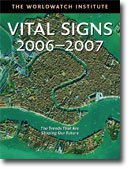States of the world

Does anyone know what in the world is going on? Depends on who you ask. These days things seem pretty grim regardless of what lens you're peering through. Assessments of where things stand on some critical global issues can be found in the following sampling of publications.
The World Factbook 2006 | CIA
The United States has carried on foreign intelligence activities since the days of George Washington but only since World War II have they been coordinated on a government-wide basis. Three programs have highlighted the development of coordinated basic intelligence since that time: (1) the Joint Army Navy Intelligence Studies (JANIS), (2) the National Intelligence Survey (NIS), and (3) The World Factbook.
The Factbook was created as an annual summary and update to the encyclopedic NIS studies. The first classified Factbook was published in August 1962, and the first unclassified version was published in June 1971. The NIS program was terminated in 1973 except for the Factbook, map, and gazetteer components. The 1975 Factbook was the first to be made available to the public with sales through the US Government Printing Office (GPO). The year 2006 marks the 59th anniversary of the establishment of the Central Intelligence Agency and the 63nd year of continuous basic intelligence support to the US Government by The World Factbook and its two predecessor programs.
To see where how the United States ranks with respect to the rest of the world, click here and scroll down.
To download the entire 2006 World Factbook, click here.

State of the World | Worldwatch Institute
This year, Worldwatch Institute's annual State of the World report provides a special focus on China and India and their impact on the world as major consumers of resources and polluters of local and global ecosystems. The report explains the critical need for both countries to "leapfrog" the technologies, policies, and even the cultures that now prevail in many western countries for the sake of global sustainability—and reports on some of the strategies that China and India are starting to implement.
Click here for more details.Vital Signs 2006-2007 | Worldwatch Institute
 This report tracks and analyzes 44 trends that are shaping our future, and includes graphs and charts to provide a visual comparison over time. Categories of trends include: Food, Agricultural Resources, Energy and Climate, Global Economy, Resource Economics, Environment, War and Conflict, Communications and Transportation, Population and Society, and Health and Disease.
This report tracks and analyzes 44 trends that are shaping our future, and includes graphs and charts to provide a visual comparison over time. Categories of trends include: Food, Agricultural Resources, Energy and Climate, Global Economy, Resource Economics, Environment, War and Conflict, Communications and Transportation, Population and Society, and Health and Disease.
Click here for more details.
State of the World Population 2006 | United Nations Population Fund
 Today, women constitute almost half of all international migrants worldwide—95 million. Yet, despite contributions to poverty reduction and struggling economies, it is only recently that the international community has begun to grasp the significance of what migrant women have to offer. And it is only recently that policymakers are acknowledging the particular challenges and risks women confront when venturing into new lands.
Today, women constitute almost half of all international migrants worldwide—95 million. Yet, despite contributions to poverty reduction and struggling economies, it is only recently that the international community has begun to grasp the significance of what migrant women have to offer. And it is only recently that policymakers are acknowledging the particular challenges and risks women confront when venturing into new lands.
Women are migrating and will continue to do so. Their needs are urgent and deserve priority attention. Only then will the benefits of international migration be maximized and the risks minimized. Women migrants are among the most vulnerable to human rights abuses—both as migrants and as females. Their hard work deserves recognition, and their human rights, protection. Their voices must be heard. Vision and leadership can help steer public debates away from reactionary sensationalism and an emphasis on “otherness” to a recognition of our common humanity, which binds us together in a world increasingly without borders.
Download the report here.
The State of The World's Children | Unicef
 The State of the World's Children 2006: Excluded and Invisible is a sweeping assessment of the world's most vulnerable children, whose rights to a safe and healthy childhood are exceptionally difficult to protect. These children are growing up beyond the reach of development campaigns and are often invisible in everything from public debate and legislation, to statistics and news stories.
The State of the World's Children 2006: Excluded and Invisible is a sweeping assessment of the world's most vulnerable children, whose rights to a safe and healthy childhood are exceptionally difficult to protect. These children are growing up beyond the reach of development campaigns and are often invisible in everything from public debate and legislation, to statistics and news stories.
Without focused attention, millions of children will remain trapped and forgotten in childhoods of neglect and abuse, with devastating consequences for their long-term well-being and the development of nations. The report argues that any society with an interest in the welfare of its children and its own future must not allow this to happen.
To download the report, click here.

0 Comments:
Post a Comment
<< Home